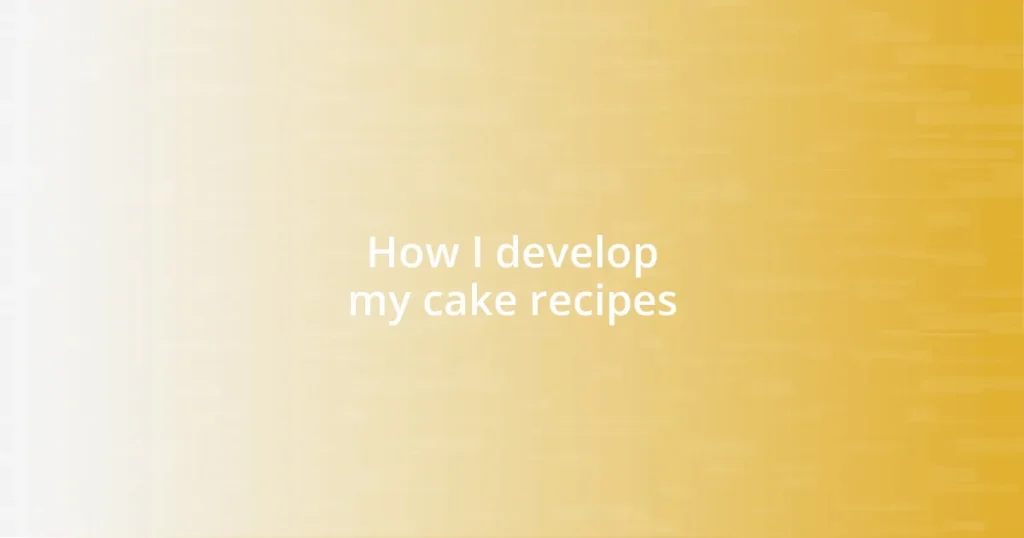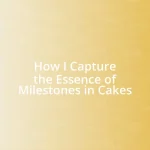Key takeaways:
- Understanding the role of ingredients like flour, sugar, and eggs can dramatically enhance cake texture and flavor.
- Choosing the right flavor combinations, such as lemon with rosemary or chocolate with sea salt, elevates the cake experience and encourages creativity.
- Documenting and refining recipes allows for consistent outcomes and the opportunity to learn from experiments, turning failures into successes.

Understanding basic cake ingredients
When I first ventured into baking, I was surprised by the impact of each ingredient on the final cake. For instance, flour is often taken for granted, but the type you use—whether all-purpose, cake flour, or even whole wheat—can significantly alter the texture. I still remember the first time I used cake flour instead of all-purpose; the cake was lighter and fluffier, and I couldn’t help but smile at how such a simple switch made a world of difference.
Then there’s sugar, which not only sweetens but also adds moisture and contributes to that tender crumb we all adore. Have you ever thought about how the sugar’s role changes depending on whether you use granulated, brown, or powdered? I vividly recall experimenting with brown sugar in a chocolate cake, and I was astonished by the deeper caramel notes it brought to the flavor. It felt like uncovering a secret ingredient that transformed an ordinary recipe into something extraordinary.
Eggs, on the other hand, are fascinating because they act as both a binding agent and a leavening component. I often wonder: how many of us truly appreciate the magic they add to our cakes? I can still recall the joy of cracking an egg into the batter and watching as it blended seamlessly, knowing it would help create the perfect rise. Each bake feels like a chemistry experiment where understanding these fundamental ingredients unlocks a world of delicious possibilities.

Choosing the right flavor combinations
Choosing the right flavor combinations is crucial for creating cakes that not only taste great but also evoke emotions. I remember my first attempt at pairing flavors; I used lemon and rosemary in a simple cake recipe. The result was unexpectedly delightful! The tartness of the lemon cut through the earthy tones of the rosemary, creating a refreshing experience that felt both sophisticated and comforting. This taught me that often the most unusual combinations can yield the most rewarding results.
When considering flavor combinations, balance is key. Think about how sweet, salty, sour, and bitter elements interact. I once made a chocolate cake and decided to add a touch of sea salt to the frosting. What a game-changer! The salt accentuated the rich chocolate flavor, making it even more indulgent. Now, I always ask myself: how can I build layers of flavor? This exploration becomes an adventure where each layer tells a story, enhancing the overall experience.
Looking at classic pairings can also be a wonderful guide. For example, combining vanilla with almond or chocolate with coffee can create comforting, familiar flavors. In my baking journey, I’ve often relied on these tried-and-true pairings, but I always encourage experimentation. Each cake is a chance to express joy, nostalgia, or even whimsy through flavor, and you never know what delightful surprises await when you step off the beaten path.
| Flavor Combination | Notes |
|---|---|
| Lemon & Rosemary | Tartness and earthiness create a refreshing, sophisticated taste |
| Chocolate & Sea Salt | Enhances richness and indulgence; creates a surprising contrast |
| Vanilla & Almond | A classic pairing that adds depth and warmth |
| Chocolate & Coffee | Intensifies the chocolate flavor, adding complexity |

Testing different baking methods
When it comes to testing different baking methods, I’ve learned that each approach can yield surprising results. One memorable experience stands out: I experimented with both the traditional creaming method and the reverse creaming technique for a vanilla cake. The difference was astonishing! The reverse method created a cake that was more tender, almost melt-in-your-mouth, and I couldn’t help but feel a rush of excitement when I discovered how varying my technique could dramatically change the texture.
Another intriguing aspect of baking is the temperature and timing. I’ve often found that slight adjustments lead to significant outcomes. Here’s a quick list of key baking methods I like to test:
- Convection Baking: This circulates the air, resulting in even baking and a wonderfully golden crust.
- Water Bath: Perfect for cheesecakes, this method keeps the cake moist and prevents cracking.
- Baking on Different Racks: I’ve found that the position in the oven can affect browning. Middle or top racks? Each one tells a different story.
- Cold Oven Method: I once tried this for an angel food cake, and it gave me that delightful, even rise I craved.
Testing these methods not only taught me about technique but also added a sense of adventure to my kitchen. Each trial felt like a small victory, one that fueled my passion for baking even further.

Adjusting for texture and moisture
When it comes to adjusting for texture and moisture in my cake recipes, I’ve discovered that small tweaks can make a huge difference. For instance, I once modified a standard chocolate cake recipe by swapping out some all-purpose flour for cake flour. The result? A lighter, more tender crumb that practically melted in my mouth. It left me wondering: why hadn’t I done this sooner?
Another essential factor is moisture. I remember the first time I added a bit of sour cream to my vanilla cake. It not only elevated the cake’s moisture level but also introduced a subtle tang that made each bite more delightful. How often do we overlook the simple ingredients that can transform a recipe? Experimenting with yogurt or buttermilk can yield similar results, bringing richness without weighing down the cake.
Timing plays a critical role, too. I found that underbaking just slightly can result in a moist texture that almost feels like a pudding cake, perfect for those who love a little gooeyness. However, overbaking transforms that bliss into dryness. It’s a delicate dance! Do I prefer a bit of risk in my baking? Absolutely! Every adjustment teaches me something new, and that’s what keeps my passion for baking alive.

Incorporating personal touches
Incorporating personal touches into my cake recipes is one of the most fulfilling aspects of baking. I still remember the time I decided to add a hint of lavender to a basic vanilla cake. The subtle floral notes transformed the entire experience, turning a simple dessert into something that felt uniquely mine. It made me realize how a single ingredient can evoke memories and emotions, creating not just a dish, but a story to share.
Sometimes, I like to think about how flavors can represent moments in my life. For instance, after a summer trip to Mexico, I was inspired to infuse my chocolate cake with a bit of cinnamon and a dash of chili powder. The result was a surprise for my friends at a gathering—sweet and spicy all in one. It’s incredible how those flavors not only delighted their taste buds but sparked conversations about travel and adventure. I find it exhilarating to blend culinary experiences with personal history.
Adding personal touches isn’t just about flavor; it’s also about presentation. One time, I baked a simple lemon cake but decided to drizzle it with homemade lemon glaze and top it with fresh strawberries from my garden. The colors just popped, and when I served it to my family, their faces lit up. It was a reminder that the way we present our food can amplify the pleasure it brings. I often wonder: how do you put your unique spin on your dishes? What memories are you sharing through your cooking?

Documenting and refining recipes
Documenting my cake recipes has been a game changer for me, allowing a methodical approach to my spontaneous baking adventures. I remember the first time I decided to jot down each step, ingredient substitution, and the subtle changes I made. It felt a bit tedious at the time, but a month later, I pulled out a forgotten recipe and was excited to replicate that delightfully fluffy cake I had made. Without that documentation, I might have missed the chance to relive that moment.
Every time I refine a recipe, it’s like embarking on a new journey. For instance, when I attempted my first gluten-free cake, my initial version was dense and crumbly—a big disappointment. I took detailed notes on ingredient ratios and bake times. After several iterations and adjustments, I finally crafted a light and airy cake that surprised even my gluten-loving friends. How satisfying it is to learn from failures and turn them into successes! I often ask myself, what will my next baking challenge be?
I also love creating a notes section in my recipe journal where I reflect on the emotional connection I have with each cake. There’s something so comforting about flipping through my entries, recalling the people I served my creations to, and the instances that sparked joy. For instance, I still smile when I think of the birthday surprise for my best friend—a rich, chocolate cake with a hint of espresso. It sparked laughter and bonding as we reminisced about our favorite coffee shops. Isn’t it fascinating how recipe documentation can revive those cherished moments?















